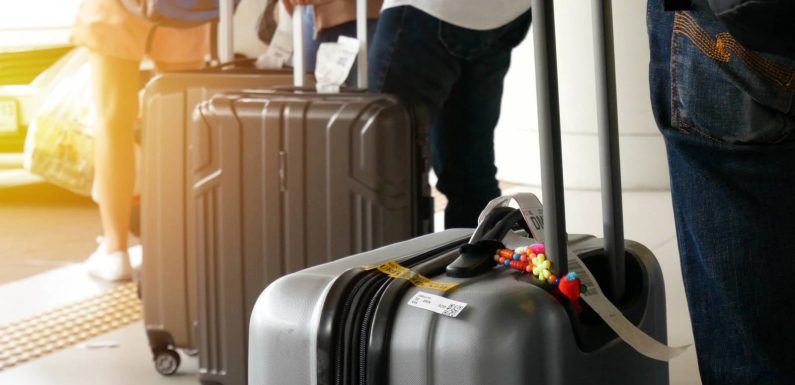
Picture this: you’re rolling through the airport after an endless red-eye flight; you’re tired, you may have had one too many glasses of complimentary in-flight wine, and you’re more than ready to get through customs, grab an Uber, drop your bags at your door, and dive into your own bed for a catnap. And then border security pulls you aside to search your luggage.
For more TPG news delivered each morning to your inbox, sign up for our daily newsletter.
That’s exactly what happened to me. I rolled up to security, my phone full of Instagram-worthy photos of my boyfriend and I traipsing through Paris together, my carry-on bag full of the secondhand luxury handbags I’ve been collecting for ten years. I was tired and sore after a red-eye from France, my Uber was almost booked — and then I had to spend two hours with border security, searching for long-gone eBay receipts and photos deep on my iCloud storage to prove my handbags were not purchased abroad.
Traveling with luxury handbags or expensive luggage is a quick way to raise suspicions when clearing customs but there are simple ways around it — if you know the tricks.
Here’s how I learned to enjoy traveling with luxury handbags despite my less than desirable incident with border security — and how I’ve managed to streamline crossing the border with big-ticket items purchased abroad. From navigating VAT returns to purchasing the right travel insurance, these tips and tricks will allow you to bring your favorite handbags and luggage along for the ride… wherever (and whenever) your next flight may take you.
Related: 9 great suitcases worth the checked-bag fee
How to care for valuable luggage or handbags while traveling
Document everything
If you plan on bringing your favorite handbag or high-end luggage with you out of the country, be prepared to prove to border security that you purchased your bag in the US. If you’re coming back into the country from Europe, security agents will be on high alert and if you’re schlepping hundreds of dollars of carry-on items with you. Chances are good that you’ll be pulled aside for extra screening.
The easiest way to keep documents in order is to take photos of your receipts if you have them and create an album on your smartphone with dated photos of the bags, the receipts, and any other relevant information. If you’re unable to prove that you had purchased your bags prior to your trip, border security has the right to seize your items and charge duty fees.
If you want to ensure your return to the US is stress-free, you can opt to register your items with US Customs before you leave the country so that you have unarguable proof that you owned your items before you left. The Certificate of Registration (CBP Form 4457) is available at any CBP office or international airport and requires a description of your item as well as the serial or date code.
Get the right travel insurance
Whether you have home insurance, group health insurance at the office, or something in between, be sure to read your policy’s fine print before heading off on your trip. A lot of the time, these built-in insurance packages only include up to a few thousand dollars worth of luxury accessories. Typical coverage for high-value items is usually around $1,000 to $2,500, and there will often be a single item limit, and many items (like wallets or suitcases) may be excluded.
Related: TPG’s comprehensive guide to independent travel insurance — including coronavirus coverage
If your home or travel insurance policy coverage isn’t enough for the number of goods you’re traveling with, consider insuring each of your items separately. This way, if the item is lost (including lost checked luggage), stolen, or damaged, you’ll be reimbursed for its full value with no deduction for depreciation or gentle use.
Maximize your carry-on space
Large handbags can be heavy and therefore tempting to pack in your checked luggage. However, whether you’ve opted for a higher insurance limit or not, I highly recommend keeping your favorite big-ticket items in your carry-on bag rather than in your checked luggage. Damage and loss can and does happen — and even if you have great insurance, you’ll want to avoid having to go through the process of claiming loss when you can. What’s more, the last thing you want is your luggage getting squished and causing your handbag to get damaged.
Gallery: 15 Ways to Save $100 to $1,000 With Minimal Effort (GOBankingRates)
Related: Keep calm and carry on: Our 13 favorite travel carry-ons
In order to maximize your carry-on space, we recommend packing one larger bag as your designated nesting bag; it should be able to fit your evening and day bags inside. If you plan on bringing more than a handful of bags, consider bringing a rolling carry-on designated to handbag and other luxury goods.
Invest in magic erasers and a reusable grocery bag
If you can help it, try not to bring the dust bags that come with your luxury goods. While they do make a great protective layer, they’re sure to raise red flags if you do get pulled aside while clearing customs. A pristine dust bag gives the appearance that you recently purchased your goods, and even if you have documented receipts and photos to prove you bought your items in the US or on previous trips, avoiding being questioned by border security means less time spent at the airport when you could be on your way home.
Instead, we recommend packing a few reusable grocery bags for emergency use. These bags serve many purposes; they’re great for covering your bags while going through airport security lines or when tucking your bags under the seat during take-off and landing. If you’re concerned about your bags getting damaged, it doesn’t hurt to pack a magic eraser to bring along with you to take care of any unexpected knicks or stains on the spot as well.
How to Bring a New Purchase Home
Bring your passport while shopping
Most European and Asian countries offer VAT refunds for big-ticket shopping (in France, for example, in order to qualify, you need to spend a minimum of 175 EUR at one store). If you’re planning on picking up a high-end souvenir, be sure to bring your passport with you when shopping to prove you’re a non-resident and eligible for the refund.
Related: How to get your maximum VAT refund
If you forgot your passport, we highly recommend putting your items on hold and running back to your hotel. The standard VAT rate in France is twenty percent, which means your $2,000 purchase at Chanel would net you $500 in VAT refunds.
Save and document every receipt
In Europe, you’ll receive a different VAT envelope at every store you make a qualifying purchase and it’s vital that you hold onto them until you’re about to leave the country where you’ll get your paperwork stamped by customs at a tax refund counter at the airport. Make sure to plan for enough time before your flight to visit the refund counter; which can sometimes be hard to find or extremely busy. Keep in mind that you technically cannot use your new purchases until you leave the country, or they will no longer qualify for the refund. Keep your bag in its dust bag and box and make sure all tags and receipts are in order.
When you do touch down in the U.S., be sure to answer the questions on the arrival card honestly. According to Matt Woodley, International Moving Expert at MoverFocus.com, “In the event Customs officers want more information or some idea of the values it is always a good idea to have supporting documentation in the form of valuations or receipts. There’s no reason to provide more information than necessary.”
Consider shipping your items back
If you’re purchasing big-ticket items that you’d prefer not to schlep through the airport and onto the plane, you’re legally allowed to ship back any luxury goods — but you’re still required to declare them.
“You can ship up to $200 worth of goods to yourself duty-free,” said Darrin Giglio, Chief Investigator North American Investigations. “However, if something is worth $500 you’ll pay on $500 instead of $300.”
When it doubt, declare it
Here’s where things can get a little dicey. Do you really have to declare that secondhand Louis Vuitton wallet? The answer is almost always yes. In most cases, you’re permitted to bring up to $800 worth of goods into the US without having to pay any duty fees — but even if your luxury purchase is well under that, you also have to take into account small purchases, like clothing, souvenirs, and alcohol. If you think you may be pushing the limit, make a detailed list of your purchases that you can share with your customs agent.
Related: What your luggage brand says about you
Note that ‘duty-free’ items aren’t always duty-free
“If you have purchased any items ‘ duty-free’ whilst you’ve been away and exceeded the limits imposed in the country you are entering, be prepared to pay duty and/or tax,” says Woodley. “Customs Officers do have discretionary powers but it is unlikely with luxury/high-ticket items that the officers will give you relief… If you can afford to purchase the items you can afford to pay the resultant duty/tax!”
Featured image by asiandelight/Getty Images
SPONSORED: With states reopening, enjoying a meal from a restaurant no longer just means curbside pickup.
And when you do spend on dining, you should use a credit card that will maximize your rewards and potentially even score special discounts. Thanks to temporary card bonuses and changes due to coronavirus, you may even be able to score a meal at your favorite restaurant for free.
These are the best credit cards for dining out, taking out, and ordering in to maximize every meal purchase.
—
Editorial Disclaimer: Opinions expressed here are the author’s alone, not those of any bank, credit card issuer, airlines or hotel chain, and have not been reviewed, approved or otherwise endorsed by any of these entities.
Source: Read Full Article










